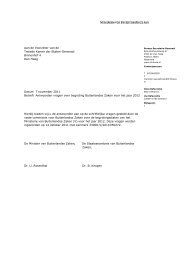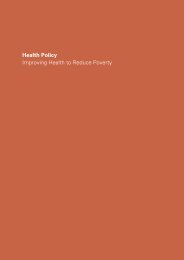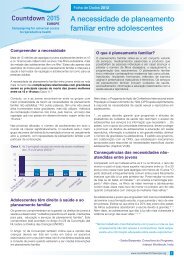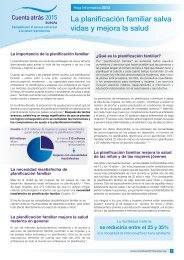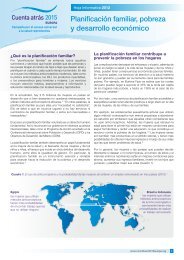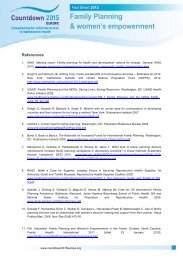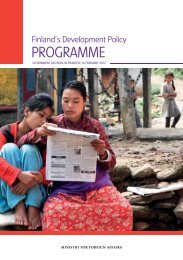The Unmet Need for Family Planning - Countdown 2015 Europe
The Unmet Need for Family Planning - Countdown 2015 Europe
The Unmet Need for Family Planning - Countdown 2015 Europe
You also want an ePaper? Increase the reach of your titles
YUMPU automatically turns print PDFs into web optimized ePapers that Google loves.
Toolkit introductionSixteen <strong>Europe</strong>an non-governmental organizations (NGOs) working in the field of sexual and reproductive health and rights (SRHR)have joined <strong>for</strong>ces under the banner of <strong>Countdown</strong> <strong>2015</strong> <strong>Europe</strong>. <strong>The</strong> group’s aim is to ensure universal access to reproductive healthand family planning.<strong>Countdown</strong> <strong>2015</strong> <strong>Europe</strong>’s current project is entitled ‘<strong>The</strong> <strong>Unmet</strong> <strong>Need</strong>: Building a more effective dialogue in <strong>Europe</strong> on the roleof family planning in poverty alleviation’, which is funded by the <strong>Europe</strong>an Commission. One of the main strategies of the project isto provide practical tools to NGOs to help them advocate <strong>for</strong> support <strong>for</strong> family planning among <strong>Europe</strong>an donors and institutions, andother NGOs and organizations. This Advocacy Toolkit <strong>for</strong> Addressing the <strong>Unmet</strong> <strong>Need</strong> <strong>for</strong> <strong>Family</strong> <strong>Planning</strong> is the main project tool.Who the toolkit is <strong>for</strong><strong>The</strong> toolkit is designed <strong>for</strong> advocates in <strong>Europe</strong> to promote increased <strong>Europe</strong>an donor support <strong>for</strong> addressing the need <strong>for</strong> familyplanning in developing countries. It may be useful <strong>for</strong> advocacy with a wide range of target audiences, including:••national government ministries, including ministers of finance, health, development, labour and other sectors;••politicians and Members of Parliament (MPs);••civil servants;••Members of the <strong>Europe</strong>an Parliament (MEPs);••<strong>Europe</strong>an Commission leaders and staff;••EU institutions; and••broader civil society, including NGOs working on issues such as health and health re<strong>for</strong>m, financial re<strong>for</strong>m, human rights,environment and population issues.How to use the toolkitThis toolkit is organized into ten chapters, each comprising evidence, statements, statistics, quotes, case studies and visual elementsthat can be used to support advocacy campaigns. All content can be ‘cut and pasted’ directly into your own organization’s documentsand other materials. It can be adapted to fit your needs; however, direct quotes should be used verbatim.Use the Category map to locate all of the content in the toolkit related to a specific category. <strong>The</strong> categories include:••Background: general in<strong>for</strong>mation about unmet need••Universal: overall reasons to support family planning••Health: individual health benefits of family planning••Poverty: how family planning contributes to poverty eradication and economic growth••Fiscal: how family planning can lead to fiscal savings <strong>for</strong> governments••Empowerment: how family planning contributes to women’s empowerment••Climate change: how family planning can help to slow population growth and address environmental and natural resourcepressures••Human rights: family planning as a human right••Strategies: best practices and strategies <strong>for</strong> addressing unmet needEach category is a plat<strong>for</strong>m from which to argue <strong>for</strong> more investment in family planning. For example, if you plan to discuss the need toinvest in family planning with a policymaker or other stakeholder whose primary interest is fiscal spending (e.g., the Minister of Finance),the Category map tells you where to find all the in<strong>for</strong>mation in the toolkit that supports the Fiscal Savings argument.Chapter 8 provides cut-and-paste charts, graphs, tables and other graphics to help you get your points across with less text.Chapter 9 provides links to external sources <strong>for</strong>:••creating customizable data tables on reproductive health and unmet need, downloadable to Excel and other software;••online tools <strong>for</strong> building charts, graphs, tables and maps (even interactive maps) using a huge range of indicators;••free (high- and low-resolution) photos relevant to development issues; and••videos about the need <strong>for</strong> investment in family planning.Chapter 10 gives you four facts sheets on key topics, which you can adapt <strong>for</strong> your own use.www.countdown<strong>2015</strong>europe.org3




